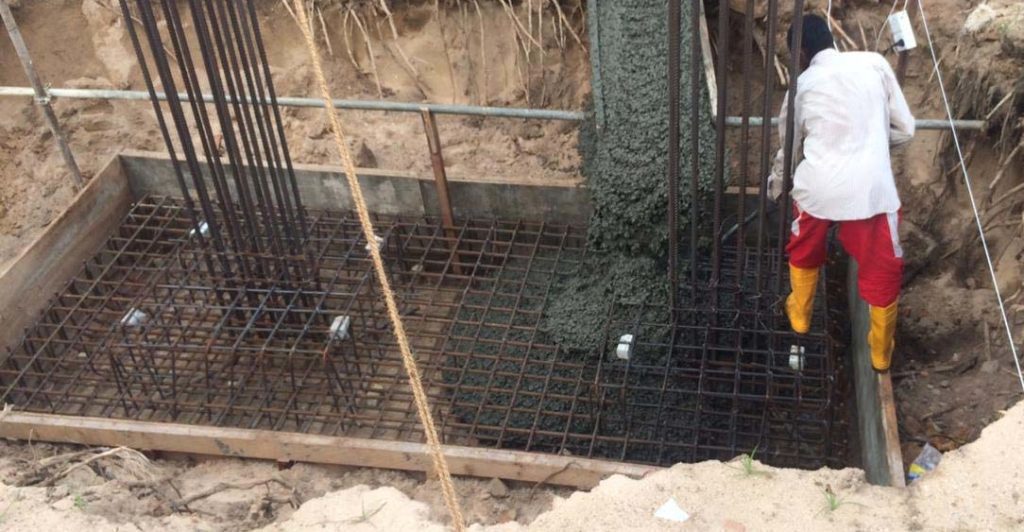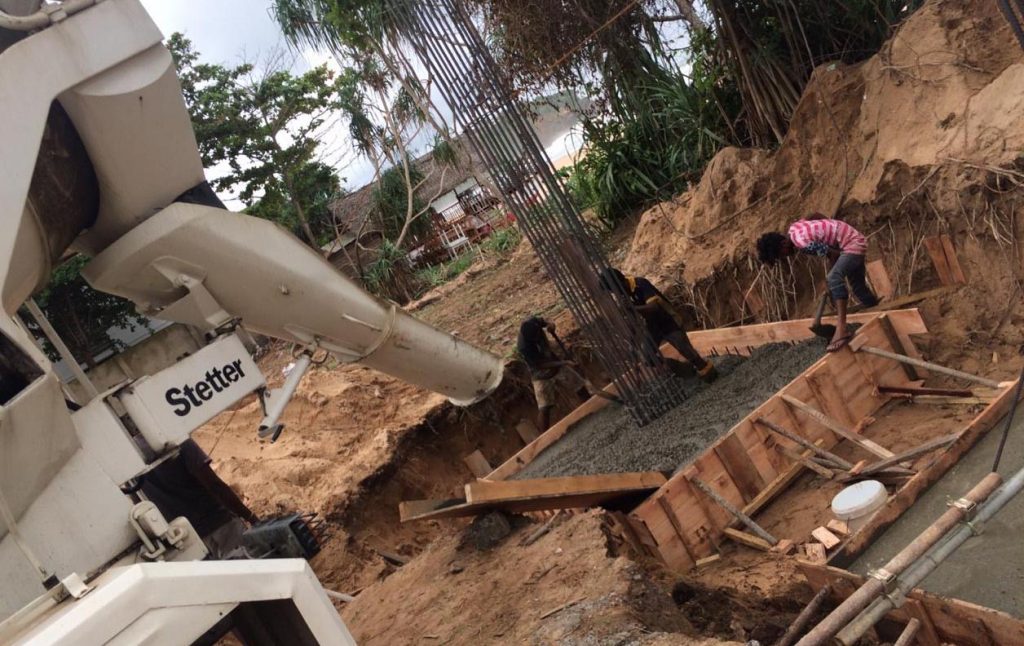Pile raft foundation is a combination of pile foundation and raft foundation. According to the geotechnical investigation and the as per the arrangement of structure, a section is made to used pile rafts.
Articles on pile foundations and raft foundations could be studied to get to know more about the design can construction of these types of foundations.
What is a Pile Raft?
The piled raft is a foundation constructed by combining both the piles and a raft foundation. Firstly, the piles are constructed and then the raft is placed combining all the piles.
Interaction of the pile, soil, and raft is the key factor considered in designing the piled raft foundation. The efficient use of the interaction leads to end up with the economical design.
Otherwise, as discussed in the latter part of this article, could not be an economical construction.
Therefore, the following interactions are incorporated into the design.
- Pile-Soil Interaction
- Pile -Pile Interaction
- Raft-Soil Interaction
- Pile-Raft Interaction
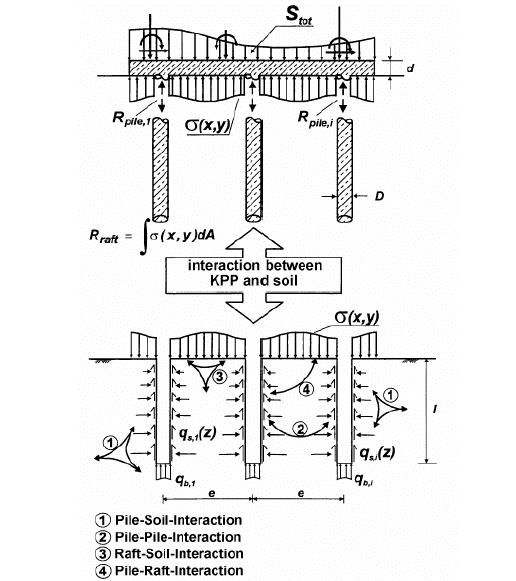
Factors Affecting Behaviour of Piled Raft Foundation
The following factors are known as important to consider when designing of piled raft foundation.
- Number of piles to be used
- Diameter of the piles
- Length of the piles
- Pile spacing ratio
- Location of piles
- Stiffness of piles
- Stiffness of Raft
- Raft dimensions
- Soil type and stiffness of the soil
- Load distribution over the piled raft
Why Pile Raft?
In general, we construct a pile foundation or raft foundations separately to transfer the loads from the superstructure to the ground.
However, in piled rafts, both the piles and raft act together as one unit to carry the loads.
Let’s see what are the advantages of having a pile in the piled raft foundation.
- The addition of the pile reduces the settlement and differential settlement.
- Mostly the pile provides its full capacity and the balance is provided by the raft.
- It improves the lateral loads resisting capacity.
- Typical, piled rafts can be observed in the high rise building where very high axial loads are applied.
- In another way, when the piles can not be socketed in the rock due to the absence of fresh rock, piled rafts are considered to resist the loads.
Design Issues of Pile Raft Foundations
According to the technical paper “Piled raft foundations: design and applications by H.G. Poulos, the following issues need to be considered during the design.
- Ultimate load capacity for vertical, lateral and moment loading
- Maximum settlement
- Differential settlement
- Raft moment and shears for the structural design of the raft
- Pile loads and moments, for the structural design of the piles
The attention shall be made to the above key factor as the behavior of the raft represented by them. Further, necessary modifications shall be done during the design in order to control the design problems.
Design Philosophies for Piled Raft Foundation
Randolph (1994) has defined their design philosophies for pile raft foundations particularly based on the load sharing between the piles and the raft.
- Conventional Approach
Piles are designed as a group to carry the majority of the loads while allowing some load to carry by the raft foundation.
- Creep Piling
Piles are designed to operate at a working load at which significant creep start to occur, typically 70% – 80% of the ultimate load capacity; sufficient piles are included to reduce the net contact pressure between the raft and the soil to below the preconsolidation pressure of the soil.
- Differential Settlement Control
Piles are located strategically in order to reduce the differential settlement rather than to reduce the overall average settlement substantially.
The above three approaches can be further discussed based on load sharing between the piles and the raft. Further, the settlement vs load curve for different cases are used to select the most suitable type of foundation system.
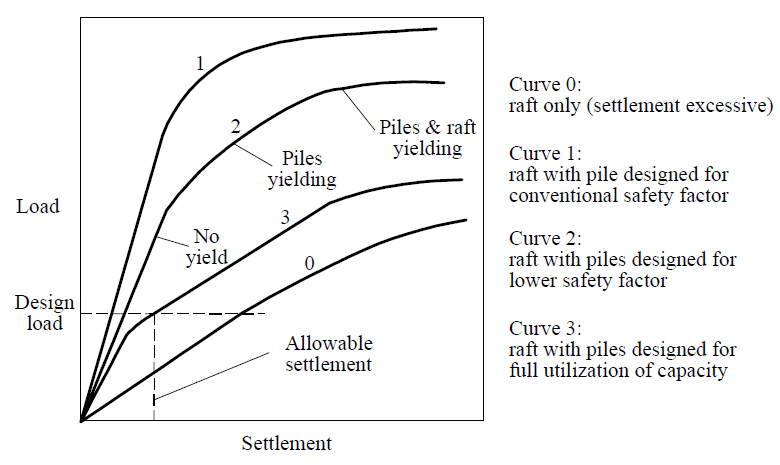
It is very important to be aware of the above settlement vs load curve to do an economical design. Based on the two strategies the conventional approach and creep piling method, the above chart is developed.
- Curve 0
It represents the behavior of the raft only and shows excessive settlement.
- Curve 1
It represents the conventional design approach where the majority of the loads are taken by the piles. The piled raft behavior is governed by the group pile behavior.
- Curve 2
It represents the creep piling behavior. Piles are operating at the lower factor of safety and more load are carrying by the raft that the curve 1.
- Curve 3
It represents the strategy of using piles as a settlement reducer. In this case, the pile full capacity is utilized when the design load is applied.
Further, the overall foundation system will be operating at an adequate factor of safety and it also satisfies the settlement criteria.
Thus, the behavior of the piled raft represented by Curve 3 is more suitable and also it is more economical when compared with other behaviors.
Effect of Ground Condition on Pile Raft Behavior
As discussed at the beginning, different interactions of the pile, soil, and raft are the key factors that cover the behavior of pile raft. Therefore, the condition of the ground is a significant effect on the load-carrying capacity of the raft.
Therefore, soil profiles containing stiff clay or dense sand is a favorable condition for the piled raft.
However, if the soil profile is subjected to the following formations, it could lead to reducing the load-carrying capacity while increasing the settlement.
- Having soft clay near the surface
- Having loose sand near the surface
- Having soft compressible layers at shallow depths
- Having soil profile likely to undergo consolidation settlement
- Having soil profiles undergo swelling movement due to external causes
Design of Piled Raft
The design of a piled raft is a very complex and tedious procedure. Due to the complexity of the analysis and other procedures, the design process is developed by Poulos is as follows.
- Preliminary Desing Stage
The possibility of using piled raft and number of piles, etc are checked.
- Second Stage
Finalize the pile locations based on the requirement and general characteristics of piles.
- Final Detail Desing Stage
The optimum number of piles, locations, and configuration is finalized. Computation of variation of settlements, raft bending moment and shear forces, pile loads and moment, etc are done in this stage.
In this article, we are more concentrated on the preliminary design stage.
Further, structural design procedures can be categorized based on the analysis method used.
- Simplified Calculation Methods
A simplified method is used to evaluate the raft. This is a kind of preliminary design like the preliminary design stage as discussed above.
- Approximate Computer Base Methods
The strip on springs approach where the raft is represented with a series of strip footings and soil is modeled with string elements. In addition, piles will also be modeled as a spring element by taking into account the stiffness.
Apart from that, a plate on the springs method could also be used under this method. In this method, the raft is repressed by plate elements while the piles are modeled with spring elements.
Both of these methods are approximation methods and it is required to do more rigorous analysis to find the actual behavior.
- More Rigorous Computer Based Methods
A simplified finite element model can be used to analyze the raft based on the final arrangement of the piled raft. Depending on the nature of the structure, the complexity of the plied raft may vary.
Simplified finite element method, three-dimensional finite element analysis, and finite difference analysis, boundary element method, etc. are a more widely known method in pile raft analysis.
Let’s discuss the preliminary design stage which is used to finalize the basic arrangement and requirement of the piled raft.
Preliminary Design Stage
The most important stage of the pile raft design is the preliminary design stage though it is called the preliminary stage.
The majority of things are finalized in this stage and we proceed with the second phase of design and detailed design stage with more information in our hands on the behavior of the piled raft.
Let’s see how it is done.
The following method of utilization of the loads in a file raft can be commonly observed.
- Pile Raft – Elastic
- Pile Capacity Fully Utilize and Raft Elastic
- Pile and Raft Reach to Ultimate Capacity
In other words, this can be discussed as follows.
- Initially, piles start to take loads. With the settlement of the pile, soil pressure under the raft also gradually develops. In this stage, Pile Raft is elastic.
- Further settlement/loads, lead piles to reach its full capacity. However, the raft is not at its full capacity which we say the raft is elastic.
- Further increase in the settlement causes both the raft and pile to their ultimate capacity.
The following figure indicates the above behavior of the pile raft foundation.
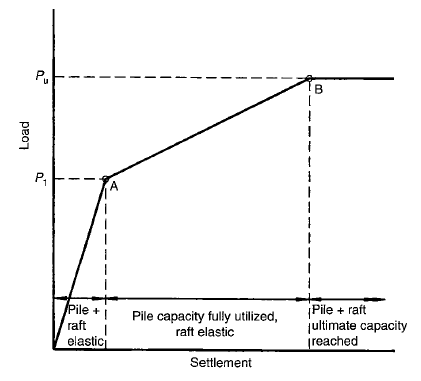
The following steps are followed in the Preliminary Desing Stage of pile rafts
- Estimate the stiffness of piled raft foundation
- Calculate the proportion of loads carried by the raft and piles
- Develop the tri-linear load settlement curve as indicated above figure.
Further clarification on the method of calculating the load sharing could be made on publication Piled Raft Foundations: Design and Applications by Harry G. Poulos.
Piled Raft Preliminary Desing Procedure
The method proposed by Randolph together with proposed design principles by Poulos is discussed in this article.
There is a slight deviation in the equations used by Randolph and the Poulos as indicated in the following design procedure. The text indicated in red color is as per the Randolph method.
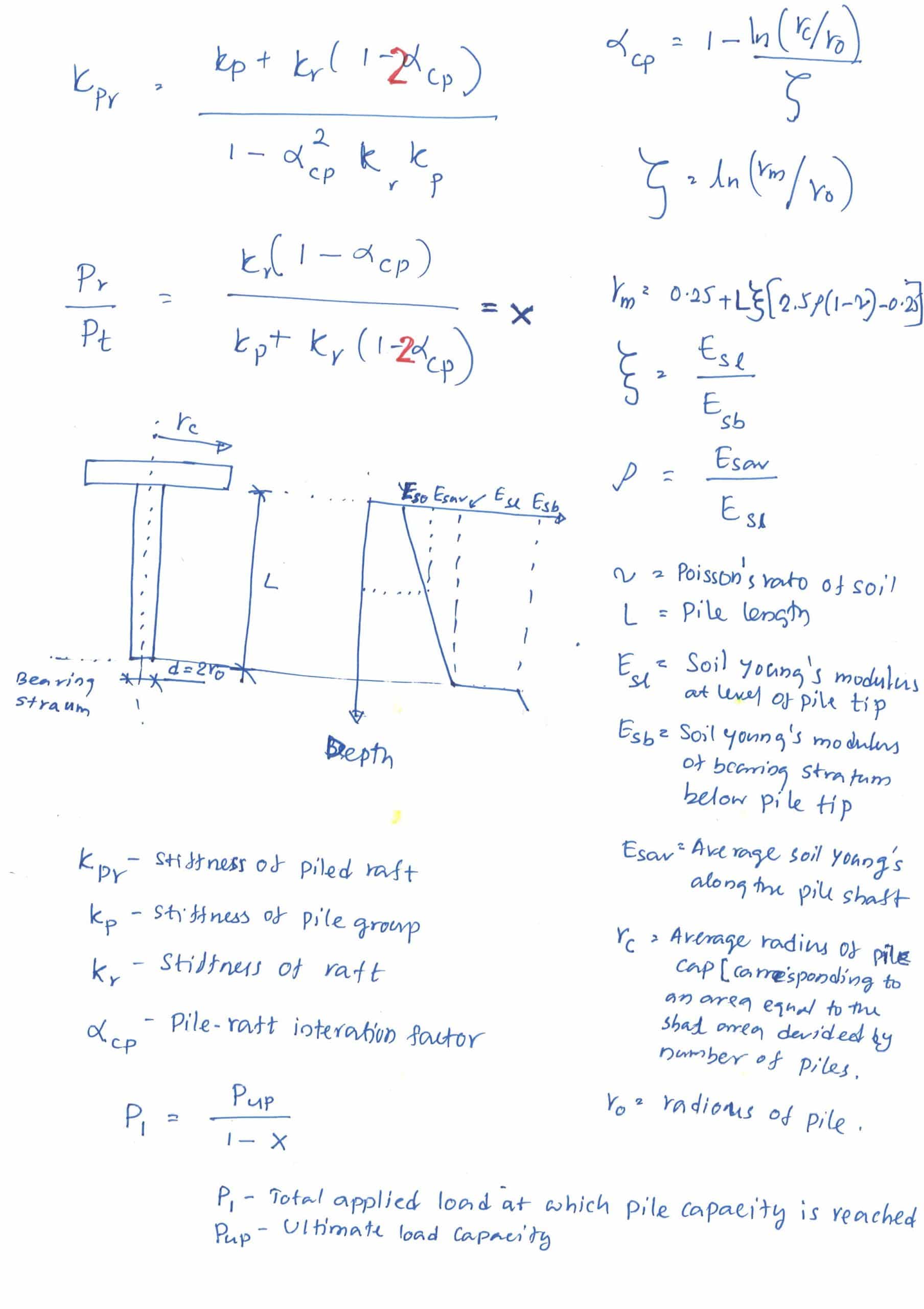
The value of the Kp can be obtained from the formula suggested by Fleming et al (1992) as shown below.
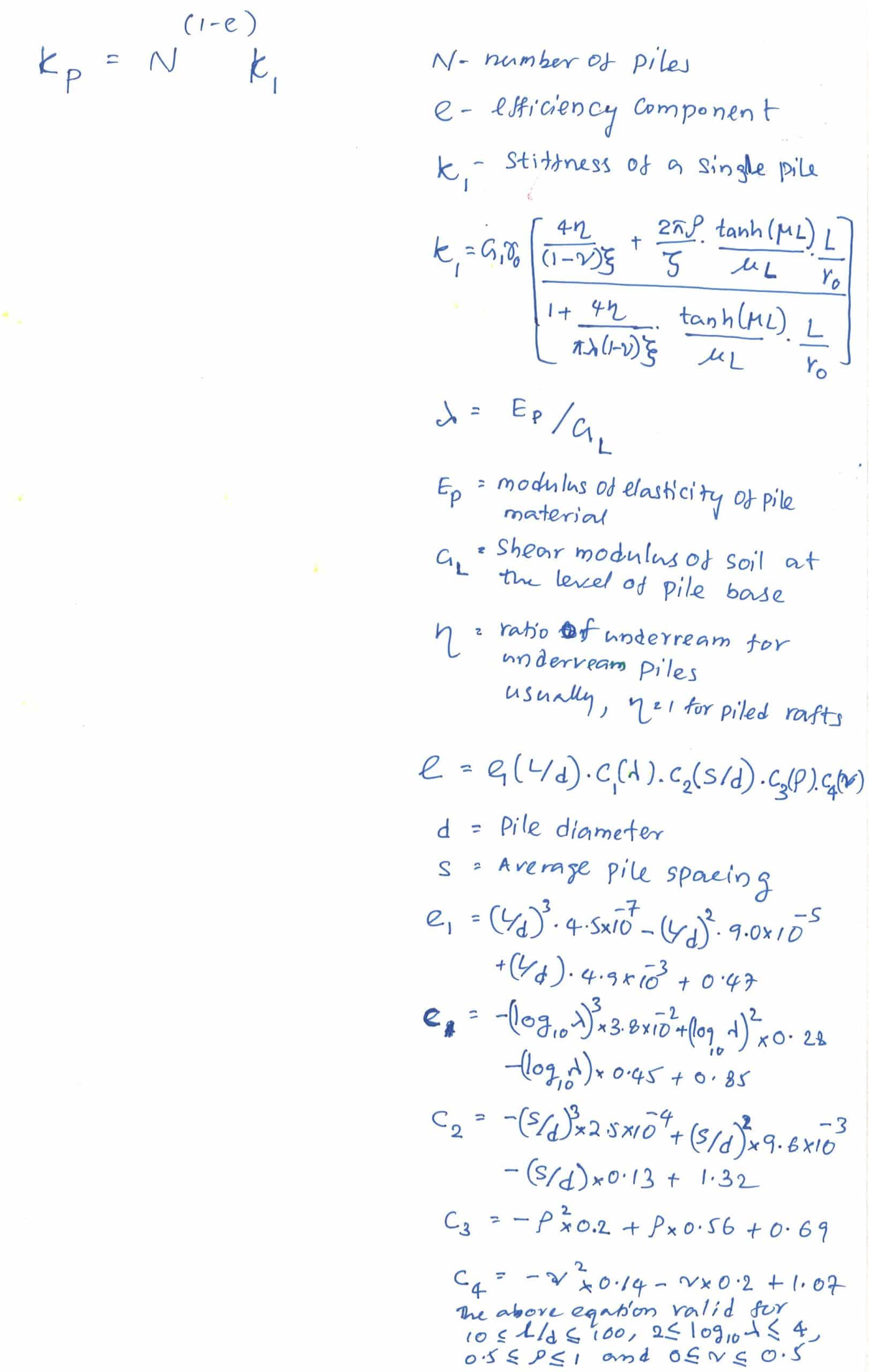
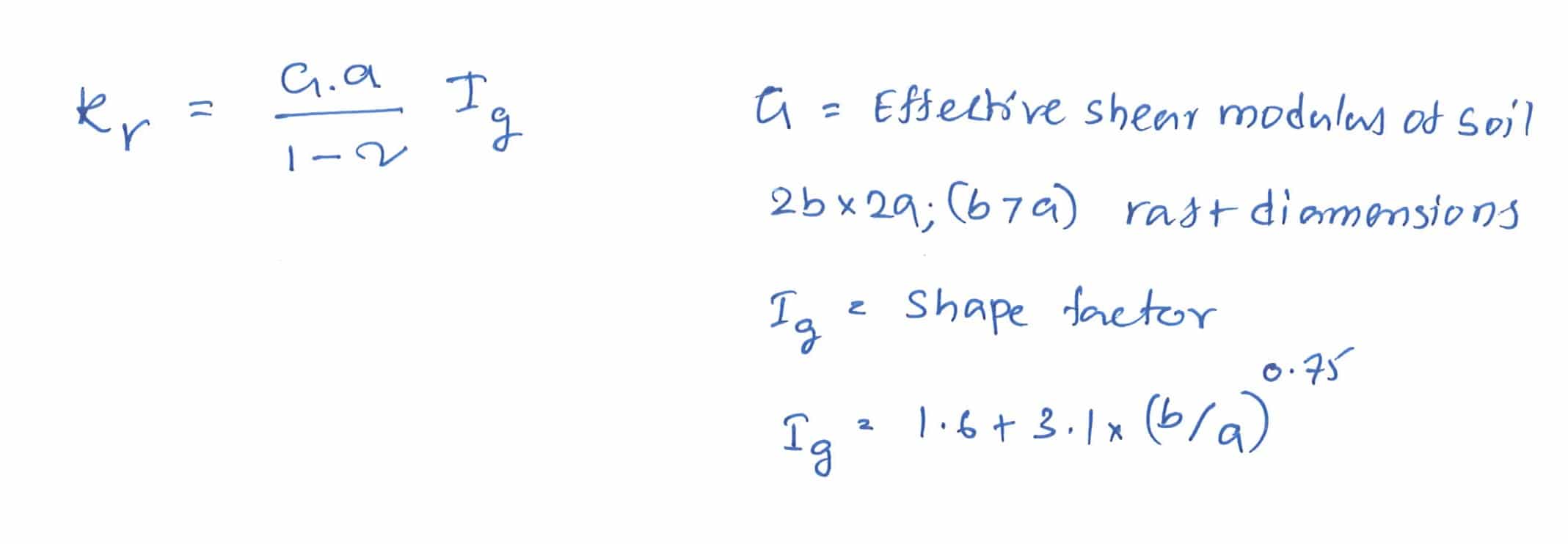
Using the above equations, we can calculate the settlement of the piled raft with the application of loads. Further, the trilinear settlement vs load curve can be developed.
There are limitations when using the above method for high rise building foundations as discussed in the technical paper Simplified analysis of piled rafts with irregular geometry by Vrettoc C. This method shall be adopted after careful study on the background and constraints.
Reference
- Piled raft foundations: Design and applications by Harry G. Poulos.
- Methods of analysis of piled raft foundations by W. F. Van Impe
- Simplified analysis of piled rafts with irregular geometry by Vrettoc C.

